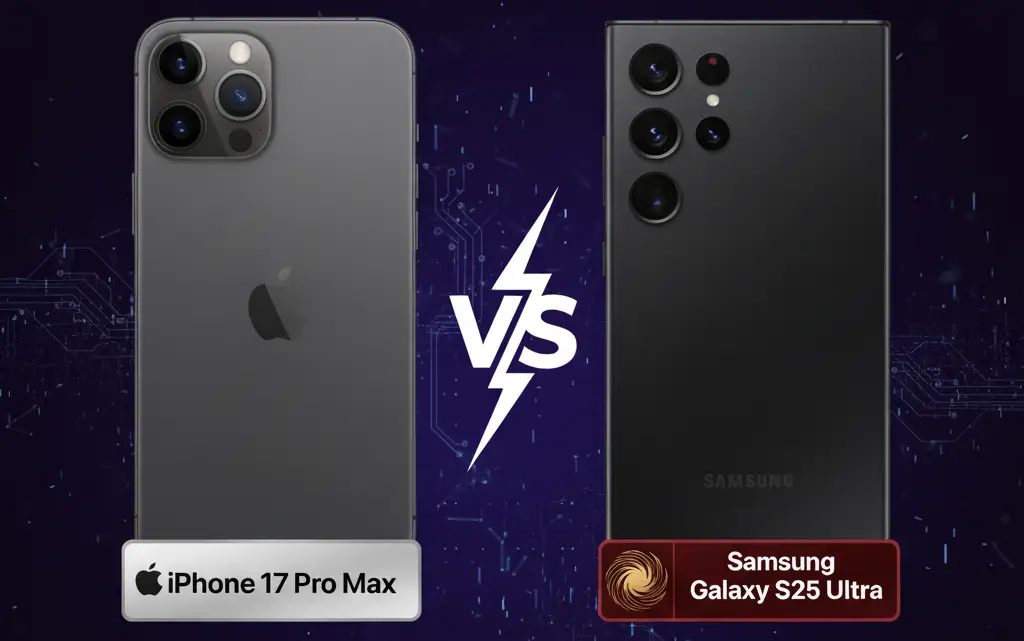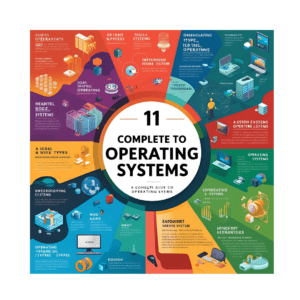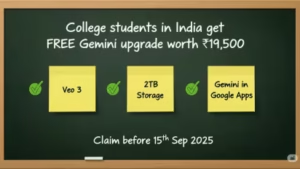
iPhone 17 Pro Max vs Samsung Galaxy S25 Ultra: The Ultimate Flagship Showdown

The battle for smartphone dominance has reached new heights in 2025 with the launch of Apple’s iPhone 17 Pro Max and Samsung’s Galaxy S25 Ultra. These two flagship devices represent the pinnacle of modern smartphone engineering — but which one deserves your attention (and your money)?
In this ultimate iPhone 17 Pro Max vs Samsung Galaxy S25 Ultra comparison, we’ll break down design, display, performance, cameras, battery, software, features, and pricing to help you decide.
Quick Comparison Table
Feature | Winner | ||
Display | 6.9″ ProMotion OLED (1–120Hz) | 6.9″ Dynamic AMOLED 2X (120Hz) | Samsung |
Peak Brightness | High brightness | 2600 nits | Samsung |
Processor | Apple A19 Pro | Snapdragon 8 Elite for Galaxy | iPhone |
RAM | 12GB | 12GB | Tie |
Storage Options | Up to 2TB | Up to 1TB | iPhone |
Main Camera | 48MP Triple | Quad Camera System | Tie |
Battery | 4832 mAh | 5000 mAh | Samsung |
Special Features | Ceramic Shield 2, Vapor Cooling | S Pen + Galaxy AI | Samsung |
Operating System | iOS | Android 15 + One UI 7 | Preference |
Build Material | Aluminum chassis | Premium materials | Tie |
Water Resistance | IP68 | IP68 | Tie |
Design and Build Quality
- iPhone 17 Pro Max marks a big shift for Apple, swapping stainless steel for a lighter aluminum chassis. It comes in Cosmic Orange, Deep Blue, and Silver, and features Ceramic Shield 2 for tougher drop resistance. A new vapor chamber cooling system ensures sustained performance.
- Samsung Galaxy S25 Ultra continues its elegant, professional look. At 218g and 8.2mm, it’s slimmer than the iPhone, with Corning Gorilla Armor 2 for top-notch scratch resistance. The iconic S Pen remains a standout, offering unmatched productivity.
Winner: Tie — Apple focuses on durability and thermal design, while Samsung excels in productivity with the S Pen.
Display Technology
Display Feature | ||
Screen Size | 6.9″ | 6.9″ |
Display Type | ProMotion OLED | Dynamic LTPO AMOLED 2X |
Resolution | High resolution | Quad HD+ |
Refresh Rate | 1–120Hz Adaptive | 120Hz |
Peak Brightness | High brightness | 2600 nits |
Biometric Unlock | Face ID | Ultrasonic fingerprint |
- iPhone 17 Pro Max: ProMotion OLED with 1–120Hz adaptive refresh, ultra-smooth and battery-efficient. Excellent in sunlight.
- Samsung Galaxy S25 Ultra: Quad HD+ AMOLED with 2600 nits brightness, HDR10+, and ultrasonic fingerprint.
Winner: Samsung Galaxy S25 Ultra — brighter, sharper, and more immersive.
Performance and Processing Power
Performance | ||
Processor | Apple A19 Pro | Snapdragon 8 Elite for Galaxy |
RAM | 12GB | 12GB |
Max Storage | 2TB | 1TB |
AI Features | Apple Intelligence | Galaxy AI |
OS Updates | 6+ years | 7 years |
- iPhone 17 Pro Max: The A19 Pro chip dominates in single-core benchmarks and energy efficiency. With up to 2TB storage, it’s perfect for professionals and creators.
- Samsung Galaxy S25 Ultra: The Snapdragon 8 Elite excels in gaming and multi-core performance, plus 7 years of Android updates.
Winner: iPhone 17 Pro Max — raw single-core power and massive storage.
Camera Systems
Camera Feature | ||
Main Camera | 48MP | High-res sensor |
Ultra-Wide | 48MP | Yes |
Telephoto | Longest optical zoom | Periscope telephoto |
Total Cameras | Triple system | Quad system |
AI Features | Apple Intelligence | Galaxy AI + Scene Optimizer |
- iPhone 17 Pro Max: Triple 48MP lenses (main, ultra-wide, telephoto) with optical zoom equivalent to 8 lenses. Exceptional for video recording and low-light shots.
- Samsung Galaxy S25 Ultra: Quad cameras with multiple telephotos and periscope zoom for superior long-range photography. AI-powered scene optimization adds flexibility.
Winner: Tie — iPhone rules video and computational photography, Samsung wins zoom versatility.
Battery and Charging
Battery Feature | ||
Capacity | 4832 mAh | 5000 mAh |
Charging | Faster than before | Fast charging |
Wireless Charging | Yes | Yes |
Reverse Wireless | No | Yes |
- iPhone 17 Pro Max: Apple’s “best-ever battery life” at 4832 mAh. Faster charging than previous iPhones (new charger may be needed).
- Samsung Galaxy S25 Ultra: Bigger 5000 mAh battery, reverse wireless charging, and established fast charging.
Winner: Samsung Galaxy S25 Ultra — bigger battery, more versatile charging.
Software and AI
- iPhone 17 Pro Max: iOS with Apple Intelligence, deep integration across iPhone, iPad, and Mac. Long-term security updates and a smooth user experience.
- Samsung Galaxy S25 Ultra: Android 15 with One UI 7, Galaxy AI, Gemini Live, Now summaries, and advanced cross-app AI features.
Winner: Samsung Galaxy S25 Ultra — more customization and AI-driven productivity.
Connectivity and Special Features
Connectivity | ||
Wi-Fi | Wi-Fi 7 | Wi-Fi 7 |
Bluetooth | 6 | Latest |
5G | All major bands | Global support |
SIM | eSIM only | Physical + eSIM |
Unique Feature | Face ID, Apple ecosystem | S Pen, DeX Mode |
Winner: Samsung Galaxy S25 Ultra — more versatile SIM support and unique productivity features.
Pricing and Value
- iPhone 17 Pro Max: Premium pricing, especially at higher storage tiers. Strong resale value for Apple loyalists.
- Samsung Galaxy S25 Ultra: Competitive pricing, trade-in deals, and frequent promotions make it more accessible.
Winner: Samsung Galaxy S25 Ultra — better value for most buyers.
Final Verdict: Which Should You Buy?
- Choose iPhone 17 Pro Max if you’re invested in the Apple ecosystem, need 2TB storage, or prioritize video recording and seamless iOS integration.
- Choose Samsung Galaxy S25 Ultra if you want the brightest display, bigger battery, S Pen features, AI productivity tools, and better pricing deals.
Overall, Winner: Samsung Galaxy S25 Ultra
For the majority of users, Samsung’s flagship model stands out with superior display brightness, longer battery life, enhanced S Pen functionality, advanced AI features, and more competitive pricing.

AUTHOR
RAHUL MEHTA
(Devices & Smartphone Specialist – Tech New Skills)
Rahul Mehta at Tech New Skills specializes in covering the latest smartphones, upcoming devices, and in-depth gadget comparisons. His expertise lies in simplifying complex specifications and trends to help readers choose the right technology with confidence.




